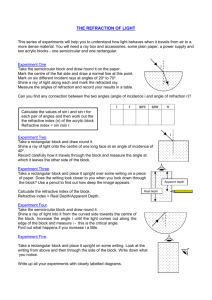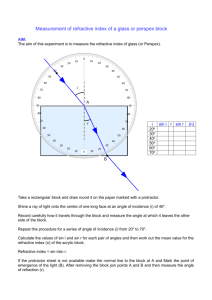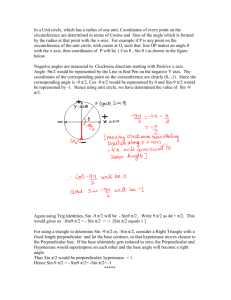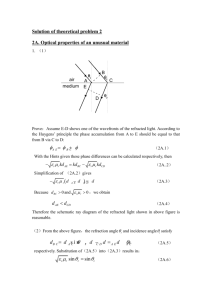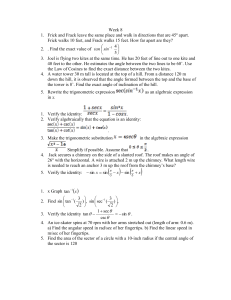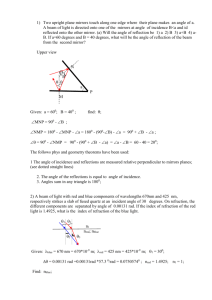1. What is the speed of light in meters per second and in miles per
advertisement
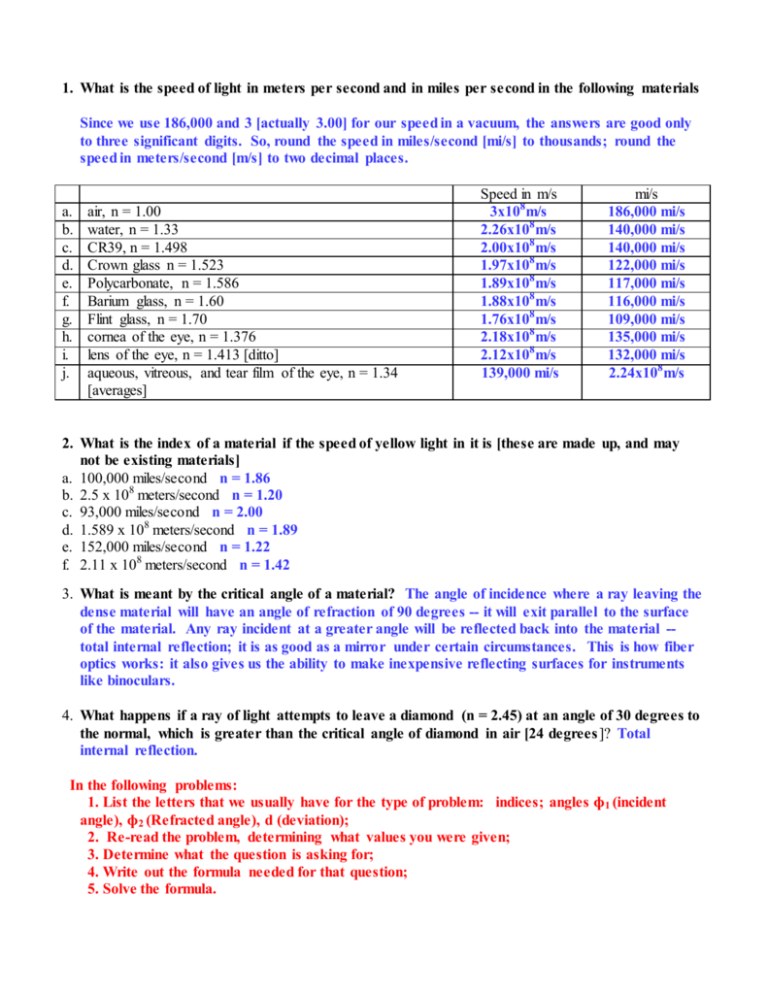
1. What is the speed of light in meters per second and in miles per second in the following materials Since we use 186,000 and 3 [actually 3.00] for our speed in a vacuum, the answers are good only to three significant digits. So, round the speed in miles/second [mi/s] to thousands; round the speed in meters/second [m/s] to two decimal places. a. b. c. d. e. f. g. h. i. j. air, n = 1.00 water, n = 1.33 CR39, n = 1.498 Crown glass n = 1.523 Polycarbonate, n = 1.586 Barium glass, n = 1.60 Flint glass, n = 1.70 cornea of the eye, n = 1.376 lens of the eye, n = 1.413 [ditto] aqueous, vitreous, and tear film of the eye, n = 1.34 [averages] Speed in m/s 3x108 m/s 2.26x108 m/s 2.00x108 m/s 1.97x108 m/s 1.89x108 m/s 1.88x108 m/s 1.76x108 m/s 2.18x108 m/s 2.12x108 m/s 139,000 mi/s mi/s 186,000 mi/s 140,000 mi/s 140,000 mi/s 122,000 mi/s 117,000 mi/s 116,000 mi/s 109,000 mi/s 135,000 mi/s 132,000 mi/s 2.24x108 m/s 2. What is the index of a material if the speed of yellow light in it is [these are made up, and may not be existing materials] a. 100,000 miles/second n = 1.86 b. 2.5 x 108 meters/second n = 1.20 c. 93,000 miles/second n = 2.00 d. 1.589 x 108 meters/second n = 1.89 e. 152,000 miles/second n = 1.22 f. 2.11 x 108 meters/second n = 1.42 3. What is meant by the critical angle of a material? The angle of incidence where a ray leaving the dense material will have an angle of refraction of 90 degrees -- it will exit parallel to the surface of the material. Any ray incident at a greater angle will be reflected back into the material -total internal reflection; it is as good as a mirror under certain circumstances. This is how fiber optics works: it also gives us the ability to make inexpensive reflecting surfaces for instruments like binoculars. 4. What happens if a ray of light attempts to leave a diamond (n = 2.45) at an angle of 30 degrees to the normal, which is greater than the critical angle of diamond in air [24 degrees ]? Total internal reflection. In the following problems: 1. List the letters that we usually have for the type of problem: indices; angles ɸ1 (incident angle), ɸ2 (Refracted angle), d (deviation); 2. Re-read the problem, determining what values you were given; 3. Determine what the question is asking for; 4. Write out the formula needed for that question; 5. Solve the formula. 5. A ray is incident on a material with an index of 1.50 at an angle of 56 degrees to the normal. If the ray is traveling from air : a. What is the angle of refraction? (Round to the nearest degree.) b. What is the angle of deviation? c. What is the speed of light in miles/second in this material? ɸ1 = 56 n1= 1.00 n2= 1.5 ? ` a. What are you looking for? ɸ2 c. What are you looking for? speed in mi/s (n1 )(sin ɸ1 ) = (n2 )(sin ɸ 2 ) 1.00 (sin 56) = 1.50(sin ɸ2 ) 0.8290 = 1.50 (sin ɸ2 ) sin ɸ2 = (0.8290) /(1.50) sin ɸ2 = 0.5527 ɸ 2 = sin-1 (0.5527 ) = 33.55º = 34 degrees b. What are you looking for? d c = 186,000 mi/s n = c/ʋ ʋ = c/n ʋ = 186,000/n ʋ = 186,000/1.50 ʋ = 124,000 mi/s d = ɸ1 - ɸ2 d = 56 - 34 d = 22 degrees 2. A ray of light exits from a material with index of 1.80, traveling into air. If the angle of refraction is 20 degrees: a. What was the original angle of incidence? (Round to the nearest degree.) b. What is the angle of deviation? c. What is the speed of light in miles/second in this material? ɸ2= 20º a. What are you looking for? ɸ 1 n1 (sin ɸ1 ) = n2 (sin ɸ2) n2 = 1 (1.80)(sin ɸ1 ) = (1.00)(sin 20) n1= 1.8 ? (1.80)(sin ɸ1 ) = 0.3420 sin ɸ1 = (0.3420)/(1.80) sin ɸ1 = 0.1900 ɸ1 = sin-1 (0.19) = 10.95º = 11 degrees b. What are you looking for? d c. What are you looking for? speed in mi/s ʋ = c/n d = ɸ1 - ɸ2 d = 11 - 20 d = -9 degrees ʋ = 186,000/n ʋ = 186,000/1.80 ʋ = 103,000 mi/s 7. If a ray of light travels from air into a transparent material at a 26 degree angle to the normal to the surface, and it is refracted through an angle of 16 degrees: a. What is the index of refraction of the unknown material? (Round to two decimal places.) b. What is the angle of deviation? (Round to the nearest degree.) [The first question is actually a practical question. We can take an unknown material, make a block with flat polished sides, shine a laser beam through it where we can measure both the angle at which the laser enters the block and where it is while it is traveling through the block, and compute the index; and from that we can actually compute how fast the light is traveling in the material!] (Air) n1 = 1 ɸ1= 26º n2 = ? ɸ2= 16º a. What are you looking for? n2 (n1 )(sin ɸ1) = (n2 )(sin ɸ2) (1.00)(sin 26) = (n2 )(sin 16) 0.4384 = (n2 )(0.2756) n2 = (0.4384)/(0.2756) n2 = 1.59 b. What are you looking for? d d= ɸ1 - ɸ2 d = 26 - 16 d = 10 degrees
